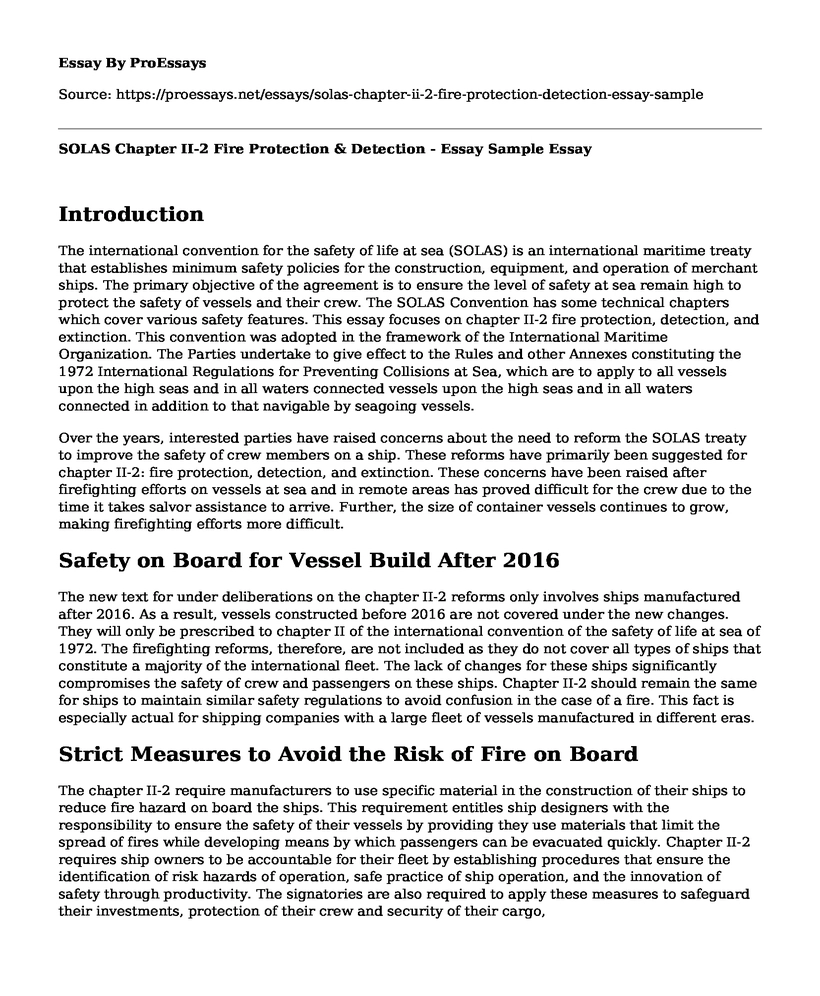Introduction
The international convention for the safety of life at sea (SOLAS) is an international maritime treaty that establishes minimum safety policies for the construction, equipment, and operation of merchant ships. The primary objective of the agreement is to ensure the level of safety at sea remain high to protect the safety of vessels and their crew. The SOLAS Convention has some technical chapters which cover various safety features. This essay focuses on chapter II-2 fire protection, detection, and extinction. This convention was adopted in the framework of the International Maritime Organization. The Parties undertake to give effect to the Rules and other Annexes constituting the 1972 International Regulations for Preventing Collisions at Sea, which are to apply to all vessels upon the high seas and in all waters connected vessels upon the high seas and in all waters connected in addition to that navigable by seagoing vessels.
Over the years, interested parties have raised concerns about the need to reform the SOLAS treaty to improve the safety of crew members on a ship. These reforms have primarily been suggested for chapter II-2: fire protection, detection, and extinction. These concerns have been raised after firefighting efforts on vessels at sea and in remote areas has proved difficult for the crew due to the time it takes salvor assistance to arrive. Further, the size of container vessels continues to grow, making firefighting efforts more difficult.
Safety on Board for Vessel Build After 2016
The new text for under deliberations on the chapter II-2 reforms only involves ships manufactured after 2016. As a result, vessels constructed before 2016 are not covered under the new changes. They will only be prescribed to chapter II of the international convention of the safety of life at sea of 1972. The firefighting reforms, therefore, are not included as they do not cover all types of ships that constitute a majority of the international fleet. The lack of changes for these ships significantly compromises the safety of crew and passengers on these ships. Chapter II-2 should remain the same for ships to maintain similar safety regulations to avoid confusion in the case of a fire. This fact is especially actual for shipping companies with a large fleet of vessels manufactured in different eras.
Strict Measures to Avoid the Risk of Fire on Board
The chapter II-2 require manufacturers to use specific material in the construction of their ships to reduce fire hazard on board the ships. This requirement entitles ship designers with the responsibility to ensure the safety of their vessels by providing they use materials that limit the spread of fires while developing means by which passengers can be evacuated quickly. Chapter II-2 requires ship owners to be accountable for their fleet by establishing procedures that ensure the identification of risk hazards of operation, safe practice of ship operation, and the innovation of safety through productivity. The signatories are also required to apply these measures to safeguard their investments, protection of their crew and security of their cargo,
The Difficulty in Detecting and Locating and Fighting Fires on Board: Is the Stcw Certificate Enough?
The size and designs of ships are continuously changing; therefore, presenting challenges for members of the crew to locate and control fires onboard a ship. The is also the use of technology onboard a ship that the crew heavily relies on to combat fire hazards onboard a ship. The STCW certificates issued to sailors are enough to ensure that the staff effectively manage fires. The STCW certificates are only offered to personnel who have portrayed practical skills in the various fields they are tested on. As a result, the certification ensures that sailors are proficient in their duties; hence, safeguarding passengers on board their ships. Sailors certified with the STCW are also competent in damage prevention of vessels. The operation of vessels may be complicated; however, with a qualified crew, operators make safer and more appropriate responses.
Difficulties of Maintenance and Inspections of the Vessels
The chapter II-2 2014 reforms will only increase the complexity and difficulty of vessel maintenance and inspection. Ships manufactured after 2016 will have different configurations to those made prior. As a result, having different standards of operations will prove inefficient for shipping companies with a fleet from different eras harder to maintain and inspect. The alternative to having reforms is to ensure that monitoring of the provisions of the STCW is sufficient enough to be considered effecting, ensuring the competence of the staff and in the prevention of accidents. Further, signatory countries of the STCW convention should ensure that they apply the provisions of these texts evenly. Finally, the STCW offers crew member a compulsory renewal of patents and certificates; therefore, motivating them to develop skills to operate vessels safely effectively.
Cite this page
SOLAS Chapter II-2 Fire Protection & Detection - Essay Sample. (2023, May 10). Retrieved from https://proessays.net/essays/solas-chapter-ii-2-fire-protection-detection-essay-sample
If you are the original author of this essay and no longer wish to have it published on the ProEssays website, please click below to request its removal:
- Essay on the Issue of Stakeholder Management and Corporate Performance
- Paper Example on Employee Productivity and Satisfaction: Motivational Ideas and Theories
- Paper Example on Recruitment Consultant
- Article Analysis Essay on College Athletes as Employees and the Politics of Title IX
- Essay on Blue Collar Workers: Education as Key to Success in Job Market
- Essay Example on Corporate Social Responsibility: Contending Definitions and Bias Claims
- Essay Example on COVID-19: Identifying the Problem Before Opening the Unit







